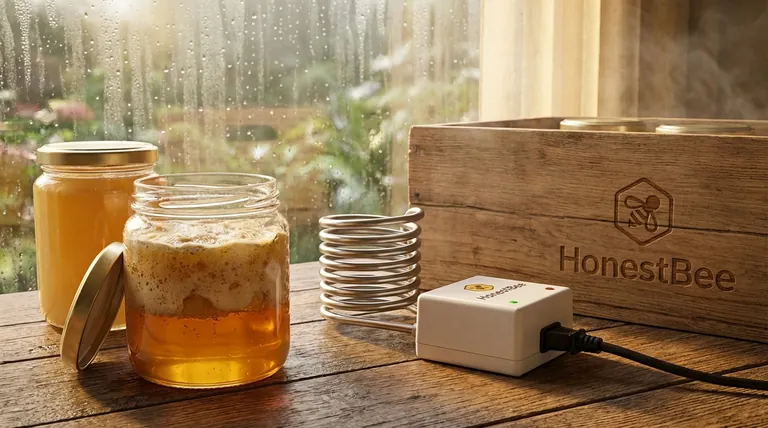At its core, high humidity alters the flavor of honey by introducing excess moisture, which activates dormant natural yeasts. This triggers a fermentation process, similar to the one used to make mead or wine. The result is the creation of acidic and alcoholic byproducts that impart a sour, "off" flavor, fundamentally degrading the honey's natural taste profile.
The central problem isn't humidity itself, but the resulting increase in honey's water content. Honey's natural longevity comes from its low moisture level; once that defense is compromised, a cascade of quality degradation, starting with fermentation, becomes inevitable.

The Core Mechanism: From Humidity to Fermentation
Honey's relationship with water is the key to its stability. High humidity directly attacks this delicate balance, setting off a chain reaction that spoils its flavor.
Honey's Natural Defense
Honey is hygroscopic, meaning it readily absorbs moisture from the surrounding environment. However, when properly cured by bees, it has a very low natural water content, typically below 18%. This low moisture level creates an environment where yeasts and other microbes cannot survive, effectively preserving the honey indefinitely.
How Humidity Breaks the Barrier
In a high-humidity environment, honey will absorb water directly from the air. This process slowly raises the internal moisture content of the honey above that critical 18% threshold, neutralizing its natural preservative effect.
Activating Dormant Yeasts
All raw honey contains natural, sugar-tolerant yeasts called osmophilic yeasts. These yeasts remain completely dormant and harmless as long as the honey's water content is low.
The Fermentation Cascade
Once the water content rises, these dormant yeasts activate. They begin to metabolize the honey's simple sugars, producing byproducts like carbon dioxide, alcohol, and acetic acid. It is these byproducts that create the distinctly sour, fermented, or alcoholic taste that ruins a batch of honey.
Secondary Effects of High Moisture
Beyond the primary impact of fermentation on flavor, elevated moisture content causes other undesirable changes that degrade the overall quality of the honey.
Reduced Viscosity
As honey absorbs water, it becomes thinner and more runny. This change in viscosity affects its texture, mouthfeel, and usability, making it less appealing for many applications.
Accelerated Crystallization
Excess moisture can disrupt the delicate balance of sugars (glucose and fructose) in honey. This can lead to faster and more widespread crystallization, altering the honey's smooth texture into a grainy one.
Microbial Growth and Spoilage
Fermenting yeasts are often the first sign of trouble, but higher water content also opens the door for other molds and microorganisms. This contamination drastically reduces the honey's shelf life and can render it completely unusable.
Common Pitfalls to Avoid
Controlling moisture is paramount, and common storage mistakes can inadvertently ruin good honey. Understanding these pitfalls is as important as understanding the science of fermentation.
The Airtight Container is Non-Negotiable
The single most common mistake is storing honey in a container that is not perfectly airtight. In a humid kitchen or pantry, even a loose-fitting lid allows for a constant exchange of air, letting the honey steadily absorb moisture over time.
The Risk of Uncured Honey
For beekeepers, a critical error is harvesting honey before it is fully "capped" with wax by the bees. Uncapped honey has not been sufficiently dehydrated, meaning its moisture content is already too high. This honey is highly susceptible to fermentation, even if stored in a dry environment.
Relying on Refrigeration
While refrigeration slows many biological processes, it is often a poor strategy for honey. The cool temperatures rapidly accelerate crystallization, and unless the container is perfectly sealed, condensation can still introduce moisture, defeating the purpose.
How to Protect Your Honey's Flavor
To maintain the quality and flavor of your honey, your strategy must be centered on one goal: controlling its moisture content.
- If your primary focus is long-term storage: Always use clean, food-grade, and completely airtight containers, and store them in a cool, dry location with a stable temperature.
- If your primary focus is harvesting (as a beekeeper): Only extract honey from frames that are at least 80% capped, as this is the bees' signal that the moisture content is safely below the fermentation threshold.
- If your primary focus is everyday use: Keep the lid on the honey jar tight and avoid leaving it open on the counter, especially in a steamy or humid kitchen.
Ultimately, protecting your honey's unique flavor profile comes down to defending it from its one true vulnerability: water.
Summary Table:
| Effect of High Humidity | Consequence for Honey |
|---|---|
| Increases Water Content | Activates dormant yeasts |
| Triggers Fermentation | Produces sour, alcoholic off-flavors |
| Reduces Viscosity | Alters texture and mouthfeel |
| Accelerates Crystallization | Creates grainy texture |
Protect Your Honey's Quality with Proper Equipment
Are you a commercial apiary or beekeeping equipment distributor struggling with honey spoilage due to humidity? HONESTBEE supplies the durable, airtight storage solutions and harvesting equipment you need to safeguard your product's flavor and extend its shelf life.
Our wholesale-focused operations provide the reliable, high-quality supplies that protect your investment from harvest to sale. Let us help you maintain the superior quality your customers expect.
Contact HONESTBEE today for wholesale pricing on equipment designed to combat humidity and preserve flavor.
Visual Guide

Related Products
- Professional Thermostatic Conical Honey Melter
- Honey Concentrating Vacuum Heating Thickening Machine Dehumidifier for Honey
- Stainless Steel Honey Tank Stand for Honey Storage
- 0.5T Capacity Honey Dehumidifier Dryer with Vacuum Heating and Thickening Filtering Machine
- Economy Small Scale Honey Dryer Dehumidifier Thickening Machine
People Also Ask
- Why is heating honey sometimes necessary? The Essential Guide to Processing & Quality
- What is the effect of heating on honey? Preserve Quality with Controlled Warming
- Why is it important to heat honey slowly and evenly? Preserve Flavor, Nutrients & Value
- What is melter honey used for? A Low-Cost Ingredient for Bakers and Brewers
- Is it safe to heat crystallized honey? Restore Your Honey's Liquid State Safely



















